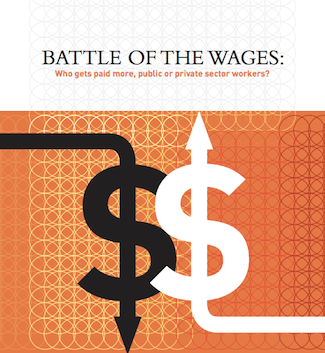
Overview
The recession and resulting public deficits have put a spotlight on public sector pay and compensation levels. Many governments have enacted pay freezes, pay constraints and are proceeding with contracting out of public services, partly on the perception that public sector workers are consistently paid more than those working in comparative jobs in the private sector.
This study uses the most detailed comprehensive data available on earnings by occupation and finds the reality is quite different. Overall average pay in the public sector is very similar to pay for comparable occupations in the private sector. Public sector pay is also considerably more equitable, whether measured by gender, age, occupational group or by region.
Key Findings:
- Overall average pay levels for comparable occupations between public and private sector employers are very similar. Average annual pay in the public sector was $49,655, 0.5 per cent higher than the private sector average of $49,407.
- This public sector “pay premium” is entirely because of a smaller pay gap for women in the public sector. This is partly the result of stronger pay equity rules in the public sector.
- Women in the public sector were paid an average of 4.5 per cent more than women in similar occupations in the private sector: $45,821 compared to $43,841 in the private sector.
- Men in the public sector were paid 5.3 per cent less on average than men in similar occupations in the private sector: $57,318 compared to $60,531 in the private sector.
- Women are still paid less than men in similar occupations in the public sector, but face a smaller pay gap than women in the private sector.
- If women in the public sector were paid the same as women working in similar jobs in the private sector, they would receive an average of $1,980 less per year, significantly increasing their pay gap.
- These findings—less of a pay gap for women and lower average pay for men than in the private sector—are consistent for all different levels of government and major areas of the broader public sector: federal, provincial, local, health and social services, and education.
- Public sector pay isn’t just more equitable for women; it’s also consistently more equitable across all major occupational groups, age groups, and regions.
- Pay differences between the public and private sectors are more significant for occupations at the top and bottom of the pay scales.
- Those working in lower paid occupations—such as cleaning, food preparation, clerks—are generally better paid in the public sector than in the private sector.
- Higher paid occupations—such as managers, lawyers and accountants—tend to be paid considerably less in the public sector than in the private sector.
- These differences would be even more stark if occupations with even larger differences had not been excluded through data quality filtering in this analysis.
- Information on the additional cost of pensions and benefits are not available on a consistent basis by occupation. However, Statistics Canada data on all supplementary labour income, including pensions and benefits, indicate these costs average 4.6 per cent more in major public sector industries than in the private sector.
Conclusions:
Overall average pay in the public sector is very similar to pay for comparable occupations in the private sector, but it is far more equitable, whether measured by gender, age, occupational group or by region.
If public sector wages and salaries followed private sector standards, the result would not only be a larger pay gap for women, but also greater inequalities across occupational groups, regions and age groups, with lower wages for the lowest paid and significant pay hikes for those at the top.
Public sector wages should reflect broader Canadian values. Wage disparities have grown too large. The International Monetary Fund (IMF), Organization for Economic Cooperation and Development (OECD) and the Conference Board of Canada have recently raised concern about the negative economic impact of growing wage and income inequality in Canada.
Methodology:
CUPE obtained the most detailed data available from Statistics Canada, with earnings information on over 500 specific detailed occupations. The study used data derived from 1.9 million records from the 2006 long-form Census and compared earnings levels for those who worked full-time, full-year for each specific occupation by industry group, with breakdowns by gender, age and region. The analysis did not adjust for other factors that can have an impact on pay, such as education, level of unionization, skills, working experience and size of employer. All these tend to be higher in the public sector workforce.
LivingWork Consultants was commissioned to analyze and aggregate the data using rigorous statistical methods. In comparison, the Wage Watch report published by the Canadian Federation of Independent Business (CFIB), which used an identical data source, used techniques that biased their results and involved equations that are mathematically incorrect.

